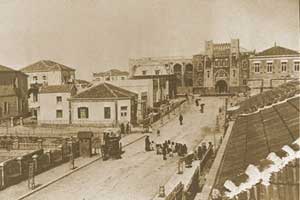Land of My Birth – The “first Hebrew city,” established in 1909 as a neighborhood named “Achuzat Bayit,” was planned from the very beginning as a modern city. The streets were wide and properly laid out according to the standards of the times, and all the streets had sidewalks. Yosef Eliyahu Shalush was the contractor who paved the streets and set the pavement on the sidewalks.
The most impressive route could be seen on Rothschild Avenue, which had four lanes, separated by rows of trees. At first it was called the “Boulevard,” using the French word for a row of trees. The original intention was not to build such a wide road, but before the construction was started a deep wadi divided the new neighborhood into two parts. In order to transform the entire area into a single flat surface a huge amount of sand was brought to fill the wadi. But it was soon discovered that no houses could be built on such a crumbly base, so it was decided to plant trees instead. Black and white pictures from that time show that Herzl Street was also quite broad. In the picture, the Herzliya Gymnasium (today the site of Migdal Shalom) can be seen at one end of the street, and a peaceful camel rests in the middle.
But this peace and quiet did not last for long. The volume of traffic in the burgeoning city grew, such that in the beginning of 5682 (1921) the local government published an “important announcement” as follows:
“In line with the declaration by the (British) government, we hereby serve notice to all the owners of carriages, automobiles, bicycles, wagons, etc, that they must be provided with brakes, so that all the vehicles can stop whenever necessary, in order to avoid accidents caused by excessive speed. This decree must be fulfilled within seven days of this proclamation, and those who violate it will be punished as severely as the law permits.”
The efforts of the municipal government and the drivers prevented any lethal accidents for the first three years, but to everybody’s dismay the first serious accident took place in 5685 (1925). A young pedestrian was killed because of reckless driving at too high a speed. The inhabitants were in great shock, and the local authorities published an “announcement and a warning” as follows:
“The traffic in the main streets has grown so much recently, in terms of cars, wagons, carriages, and camels, that there is a constant danger for all pedestrians, because of the great speed of the cars. The result was the terrible tragedy that occurred to the child Devorah Bat Shmuel Gross, whom we mourn deeply, and we want to console her parents. In order to prevent similar cases in the future, the local authorities have decided as follows:
“(1) All pedestrian traffic on the sidewalks or in the streets must be only on the right side. (2) All movement of cars, carriages, wagons, camels, donkeys, and horses must also be only on the right of the road. (3) Cars may not be driven within the boundaries of Tel Aviv at a speed greater than ten kilometers per hour (the speed limit was emphasized in bold print in the original announcement). (4) It is forbidden to move camels or donkeys in the streets unless they are tied to each other. Not more than four camels or five donkeys may be tied together. (5) Drivers of cars and carriages and bicycle riders must blow their horns in order to warn the passersby at the corners of the streets and whenever they are about to turn.”
Since that time, the Yarkon River has witnessed much activity, and the young city has become a metropolis. The narrow streets have been replaced by busy intersections through which tens of thousands of modern vehicles pass every day. However, traffic accidents have not stopped, they are on the increase. Our only wish for Tel Aviv as it approaches its hundredth year is that it will continue to progress in the realm of road safety, in order to decrease the number of unnecessary traffic victims.
Source: The website, “Families of the Founders of Tel Aviv”. Reprinted with permission from Zomet Institute (www.zomet.org.il). Translated from the Hebrew by Moshe Goldberg. To subscribe to receive the complete version of Shabbat B’Shabbato please write to dan@zomet.org.
The words of this author reflect his/her own opinions and do not necessarily represent the official position of the Orthodox Union.
